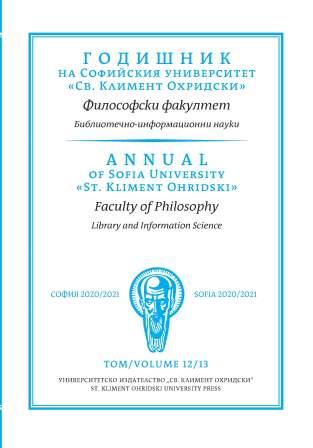ИСТОРИЯТА НА КНИГАТА : ТЕМИ, ПРОБЛЕМИ, АКЦЕНТИ В СЪВРЕМЕННИТЕ ЗАПАДНИ ИЗСЛЕДВАНИЯ
BOOK HISTORY : TOPICS, PROBLEMS, FOCAL AREAS IN MODERN WESTERN STUDIES
Author(s): Boryana YankovaSubject(s): History, Cultural history, Library and Information Science, Education and training
Published by: Софийски университет »Св. Климент Охридски«
Keywords: book history; communication circuit; print culture
Summary/Abstract: The article examines the subject of the history of the book as a scientific discipline and the trends in the studies of leading print cultures in the West, as well as, in brief, the contribution of the main East European schools. The theoretical part of the text introduces the debate among historians, represented mostly by Robert Darnton, advocating the theory of common methodology in the study of processes, and David Hall, according to whom the history of the book unites several common topics. The viewpoints of social history and bibliography find expression in the segments of the communication circuit of R. Darnton and the bibliocentric model of the entire socioeconomic situation, developed by bibliographers Thomas Adams and Nicolas Barker. Chronologically, the historical part presents the most significant focal areas and sustain- able trends, visible to this day in the print culture of Germany, Italy, France, Great Britain, the Scandinavian countries and America, which create the leading cultural models. Among these are the book fairs, the first translations of the Bible into national languages, the spread of accessible genres, such as “bibliothèque blue”, the beginning of public libraries, the change and the meaning of the literary format, and the resulting social phenomena, such as intensive and extensive reading, reading spaces, mass audience, legal regulations, copyright, etc. The text presents the development of the concept of a general history of the book, as well as with the scientific contribution of each one of them, and the approach to key phenomena.
- Issue Year: 2021
- Issue No: 12-13
- Page Range: 52-76
- Page Count: 28
- Language: Bulgarian

